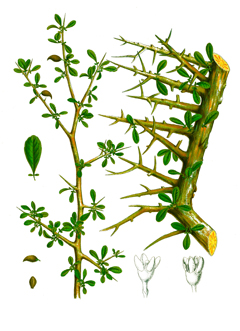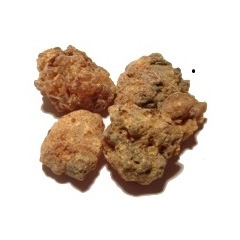 |
|
https://edibleplants.org/ |
 |
| wikimedia.org |
Translate this page:
Summary
Myrrh, Commiphora myrrha, is a deciduous spiny tree that grows up to 5 m high and 1.5 m wide. The leaves are oblong to oval and have 3 leaflets per leaf. Each leaflet is about 1 cm long. The four-petal flowers are yellow-red and narrowly oval. It is drought and frost-tolerant. It is propagated by seeds or cuttings. It is otherwise known as Dheddin. The bark yields a fragrant resin used as flavouring fir sweets, baked goods, beverages, chewing gum, and desserts. It is also used in perfumery and as incense. The resin promotes healing and relieves spasms, inflammation and digestive discomfort. If taken internally, it treats dyspepsia, infections of the ear, tonsillitis, fever, etc. The resin yields essential oil which is used for treating skin and mouth problems. The plant is used externally for wounds, boils, and mouth ulcers, and added to oral preparations.
Physical Characteristics

 Commiphora myrrha is a deciduous Shrub growing to 5 m (16ft) by 6 m (19ft) at a medium rate.
Commiphora myrrha is a deciduous Shrub growing to 5 m (16ft) by 6 m (19ft) at a medium rate.
See above for USDA hardiness. It is hardy to UK zone 10 and is not frost tender.
Suitable for: light (sandy), medium (loamy) and heavy (clay) soils, prefers well-drained soil and can grow in nutritionally poor soil. Suitable pH: neutral and basic (mildly alkaline) soils and can grow in very alkaline soils.
It cannot grow in the shade. It prefers dry or moist soil and can tolerate drought.
UK Hardiness Map
US Hardiness Map
Synonyms
Balsamea myrrha (T.Nees) Oken Balsamea myrrha Baill. Balsamea playfairii Engl. Balsamodendrum myrrha
Plant Habitats
Edible Uses
Edible Parts: Inner bark
Edible Uses: Condiment Gum
A fragrant, balsam-like gum oleo-resin is obtained from wounds in the bark of the stems[ 46 ]. It is used for flavouring beverages, baked goods, sweets, desserts, chewing gum etc[ 301 ].
References More on Edible Uses
Medicinal Uses
Plants For A Future can not take any responsibility for any adverse effects from the use of plants. Always seek advice from a professional before using a plant medicinally.
Antiinflammatory Antiseptic Antispasmodic Aromatherapy Aromatic Astringent Digestive Expectorant
Febrifuge Mouthwash Odontalgic Skin Stimulant
The resin obtained from the bark of myrrh is a pungent, astringent, aromatic herb that is strongly stimulant, antiseptic and expectorant[ 238 ]. It relieves spasms, inflammation and digestive discomfort, and encourages healing[ 238 ]. It is particularly associated with women's health and purification rituals[ 238 ]. The resin is taken internally in the treatment of dyspepsia, bronchial and ear infections, glandular fever, tonsillitis, pharyngitis, gingivitis, menstrual and circulatory problems[ 238 ]. Myrrh is used externally to treat mouth ulcers, wounds and boils and is often added to oral preparations[ 238 ]. It is one of the most effective herbal medicines for treating sore throats, mouth ulcers and gingivitis[ 254 ]. The mild astringency makes it a useful treatment for acne, boils and mild inflammatory skin problems[ 254 ]. The resin is collected from cut branches and dried to a solid, which can be distilled for oil, ground into a powder for tablets, or dissolved in tinctures[ 238 ]. An essential oil obtained from the resin is used by aromatherapists as a natural antiseptic for treating skin and mouth problems[ 303 ].
References More on Medicinal Uses
The Bookshop: Edible Plant Books
Our Latest books on Perennial Plants For Food Forests and Permaculture Gardens in paperback or digital formats.

Edible Tropical Plants
Food Forest Plants for Hotter Conditions: 250+ Plants For Tropical Food Forests & Permaculture Gardens.
More

Edible Temperate Plants
Plants for Your Food Forest: 500 Plants for Temperate Food Forests & Permaculture Gardens.
More

More Books
PFAF have eight books available in paperback and digital formats. Browse the shop for more information.
Shop Now
Other Uses
Cosmetic Essential Gum Resin Soil stabilization Teeth
Agroforestry Uses: An important species protecting soil in wind erosion prone areas[ 303 ]. Other Uses A hard, translucent, yellowish gum-resin is obtained from wounds in the stem[ 46 ]. It has an aromatic taste and odour, but may be acrid and bitter[ 303 ]. It is inflammable, but burns feebly[ 299 ]. It is used for perfumery and as an incense during religious ceremonies[ 46 ]. It was also originally used in embalming[ 46 ]. Myrrh is a common ingredient of toothpowder, and is used with borax in tincture, with other ingredients, as a mouth-wash[ 303 ]. An essential oil can be obtained from the plant[ 303 ]. (From the resin?[ K ].) The oil is deep amber in colour with a warm, spicy, bitter and smoky aroma. Myrrh oil is considered helpful for meditation, and aromatherapists recommend the naturally antiseptic essential oil for skin and mouth problems[ 303 ].
Special Uses
Scented Plants
References More on Other Uses
Cultivation details
A plant for the drier tropics and subtropics, where it can be found at elevations from 250 - 1,300 metres[ 238 , 303 ]. Plants prefer a minimum temperature that does not fall below about 10°c[ 238 ]. It grows wild in areas where the mean annual rainfall is within the range 230 - 300mm[ 303 ]. Requires a well-drained soil and a position in full sun[ 238 ]. Prefers shallow soils and is chiefly found over limestone[ 303 ]. Drought-tolerant; suitable for xeriscaping.
References Carbon Farming Information and Carbon Sequestration Information
Temperature Converter
Type a value in the Celsius field to convert the value to Fahrenheit:
Fahrenheit:
The PFAF Bookshop
Plants For A Future have a number of books available in paperback and digital form. Book titles include Edible Plants, Edible Perennials, Edible Trees,Edible Shrubs, Woodland Gardening, and Temperate Food Forest Plants. Our new book is Food Forest Plants For Hotter Conditions (Tropical and Sub-Tropical).
Shop Now
Plant Propagation
Seed - Hardwood cuttings at the end of the growing season[ 238 ].
Other Names
If available other names are mentioned here
Myrrh, Commiphora myrrha. other Names: Dheddin. African myrrh, herabol myrrh, Somali myrrhor, common myrrh, or gum myrrh.
Native Range
TEMPERATE ASIA: Oman, Yemen AFRICA: Djibouti, Ethiopia (east), Somalia, Kenya (northeast)
Weed Potential
Right plant wrong place. We are currently updating this section.
Please note that a plant may be invasive in one area but may not in your area so it's worth checking.
None Known
Conservation Status
IUCN Red List of Threatened Plants Status : This taxon has not yet been assessed

Growth: S = slow M = medium F = fast. Soil: L = light (sandy) M = medium H = heavy (clay). pH: A = acid N = neutral B = basic (alkaline). Shade: F = full shade S = semi-shade N = no shade. Moisture: D = dry M = Moist We = wet Wa = water.
Now available:
Food Forest Plants for Mediterranean Conditions
350+ Perennial Plants For Mediterranean and Drier Food Forests and Permaculture Gardens.
[Paperback and eBook]
This is the third in Plants For A Future's series of plant guides for food forests tailored to
specific climate zones. Following volumes on temperate and tropical ecosystems, this book focuses
on species suited to Mediterranean conditions—regions with hot, dry summers and cool, wet winters,
often facing the added challenge of climate change.
Read More
Expert comment
Author
(Nees) Engl.
Botanical References
Links / References
For a list of references used on this page please go here
A special thanks to Ken Fern for some of the information used on this page.
Readers comment
| Add a comment |
|
If you have important information about this plant that may help other users please add a comment or link below. Only comments or links that are felt to be directly relevant to a plant will be included. If you think a comment/link or information contained on this page is inaccurate or misleading we would welcome your feedback at [email protected]. If you have questions about a plant please use the Forum on this website as we do not have the resources to answer questions ourselves.
* Please note: the comments by website users are not necessarily those held by PFAF and may give misleading or inaccurate information.
To leave a comment please Register or login here All comments need to be approved so will not appear immediately.
|
Subject : Commiphora myrrha
|
|
|
|